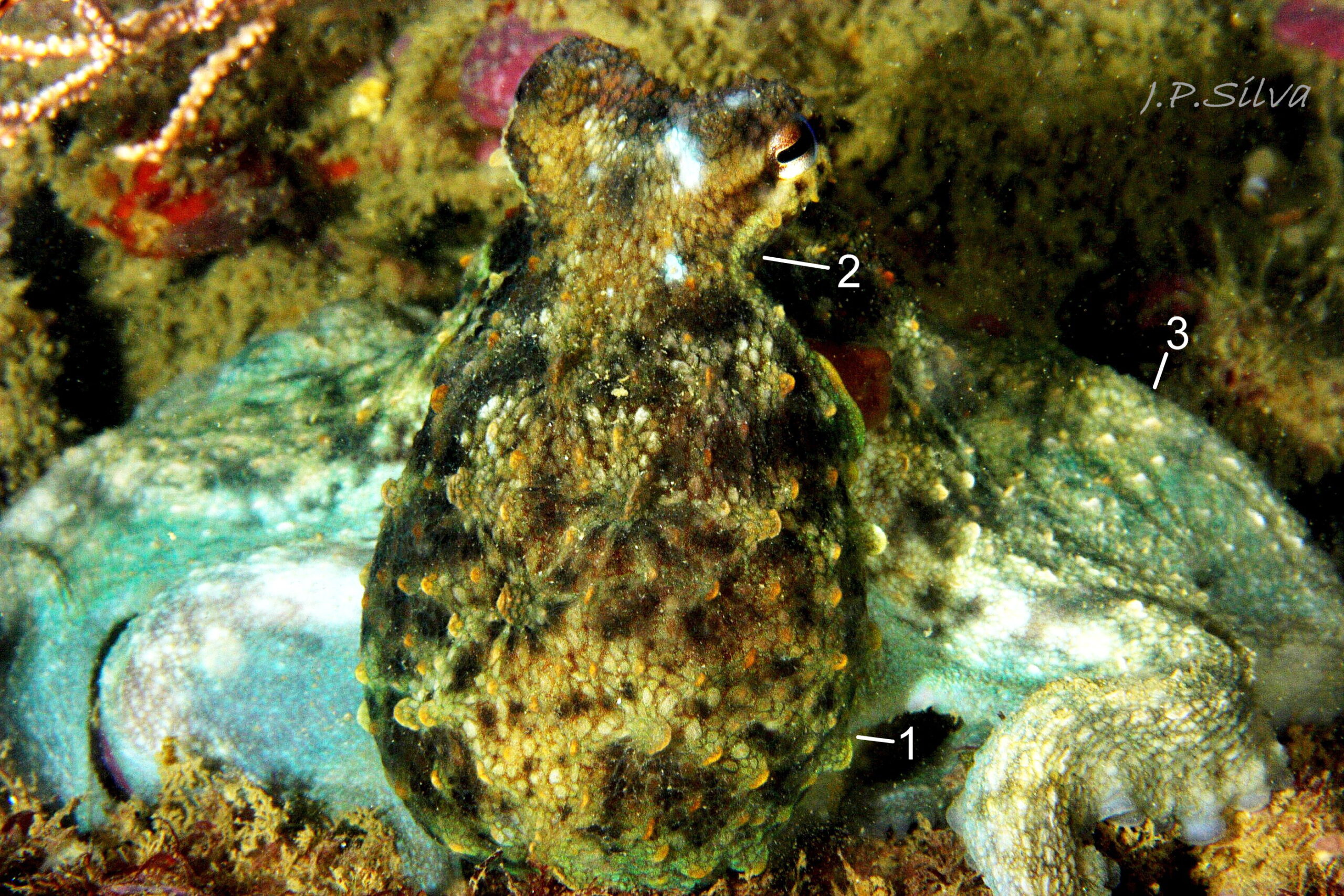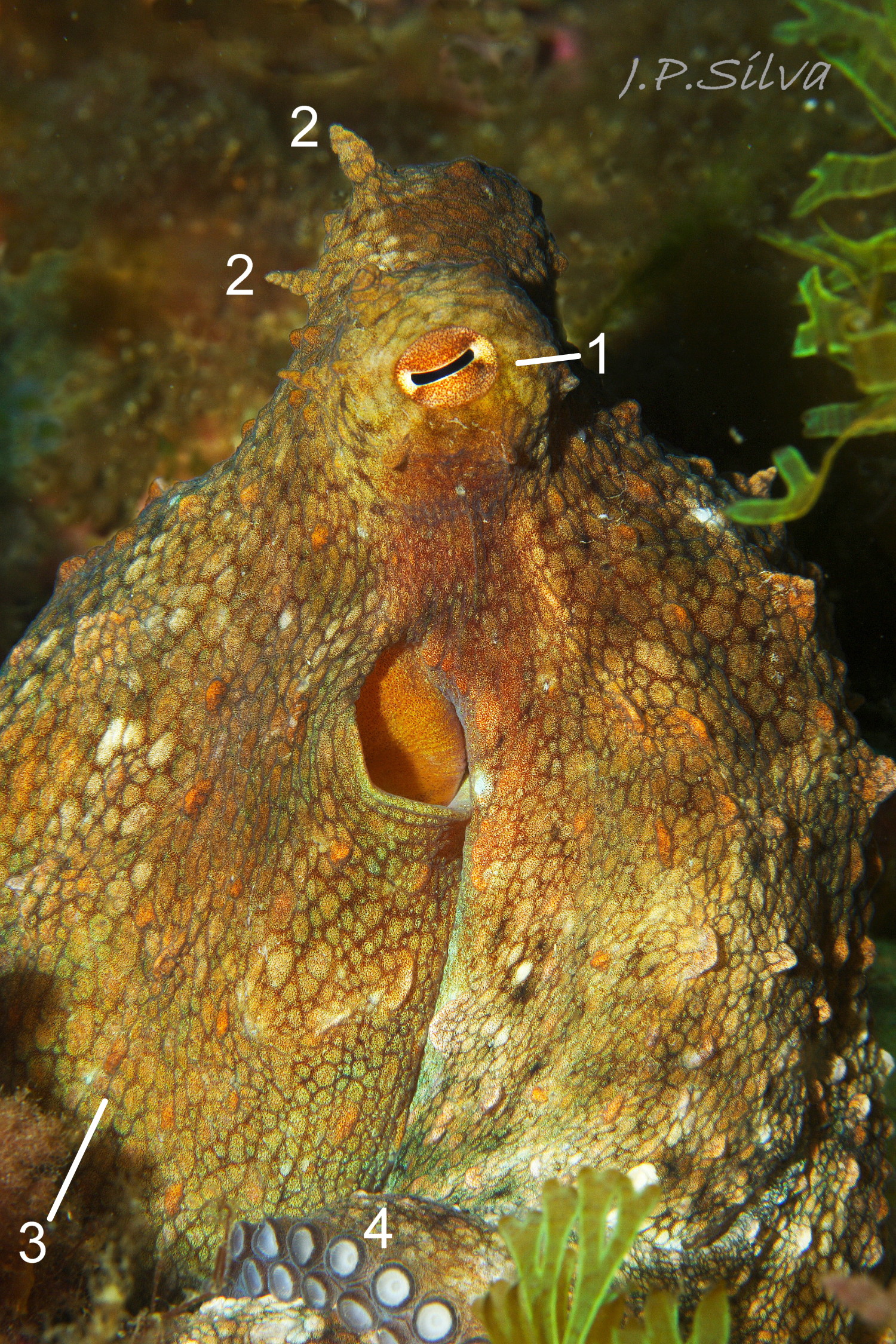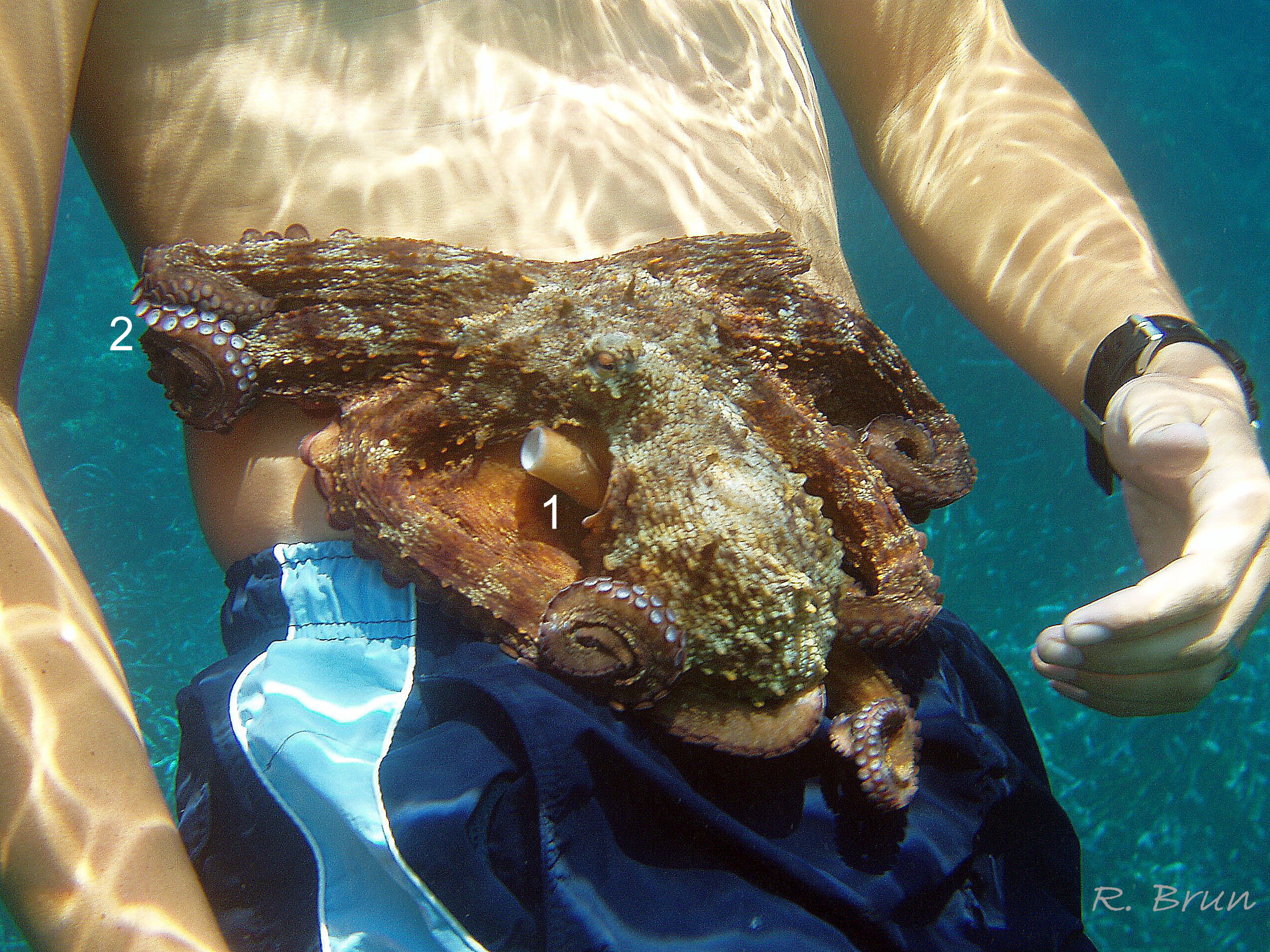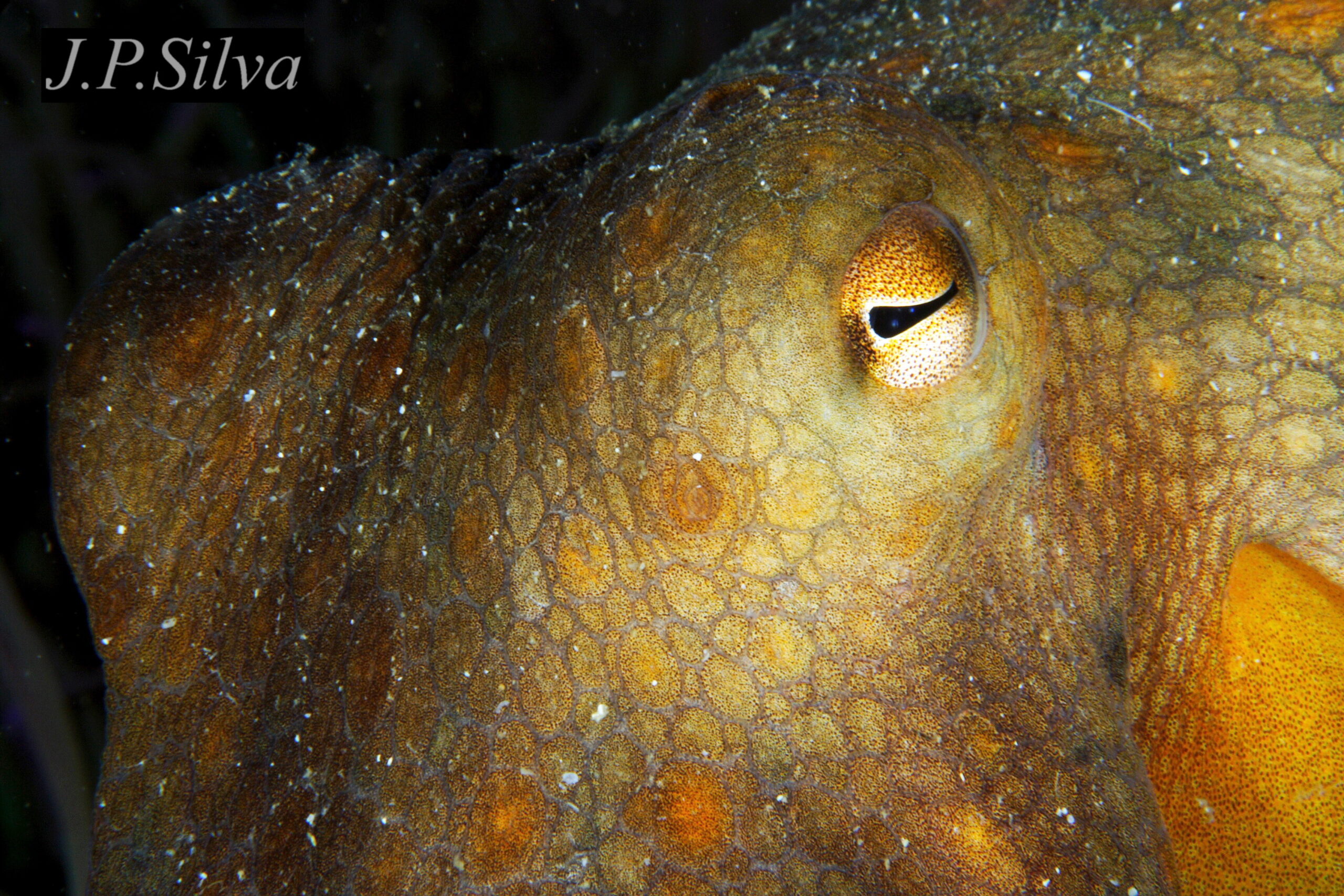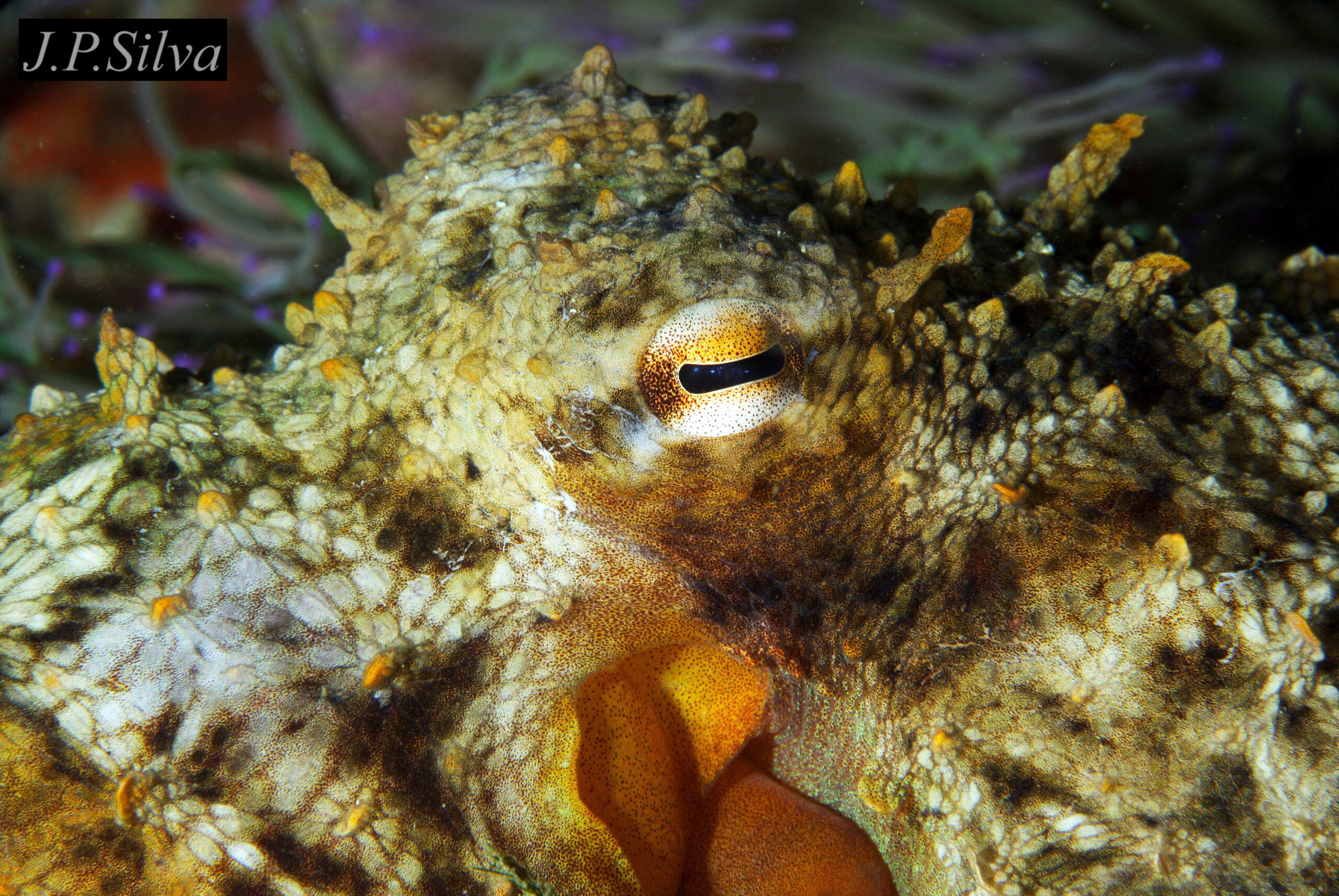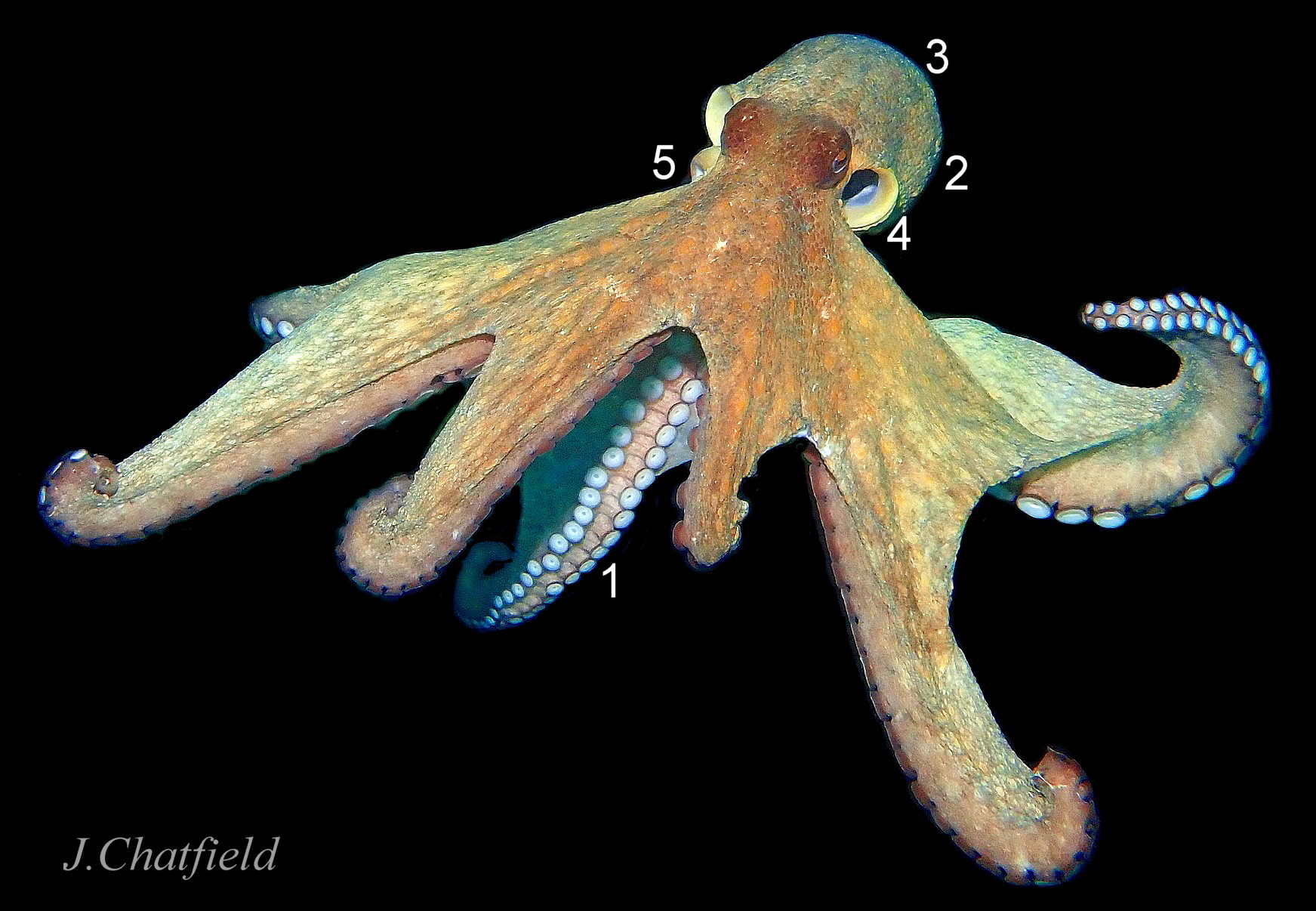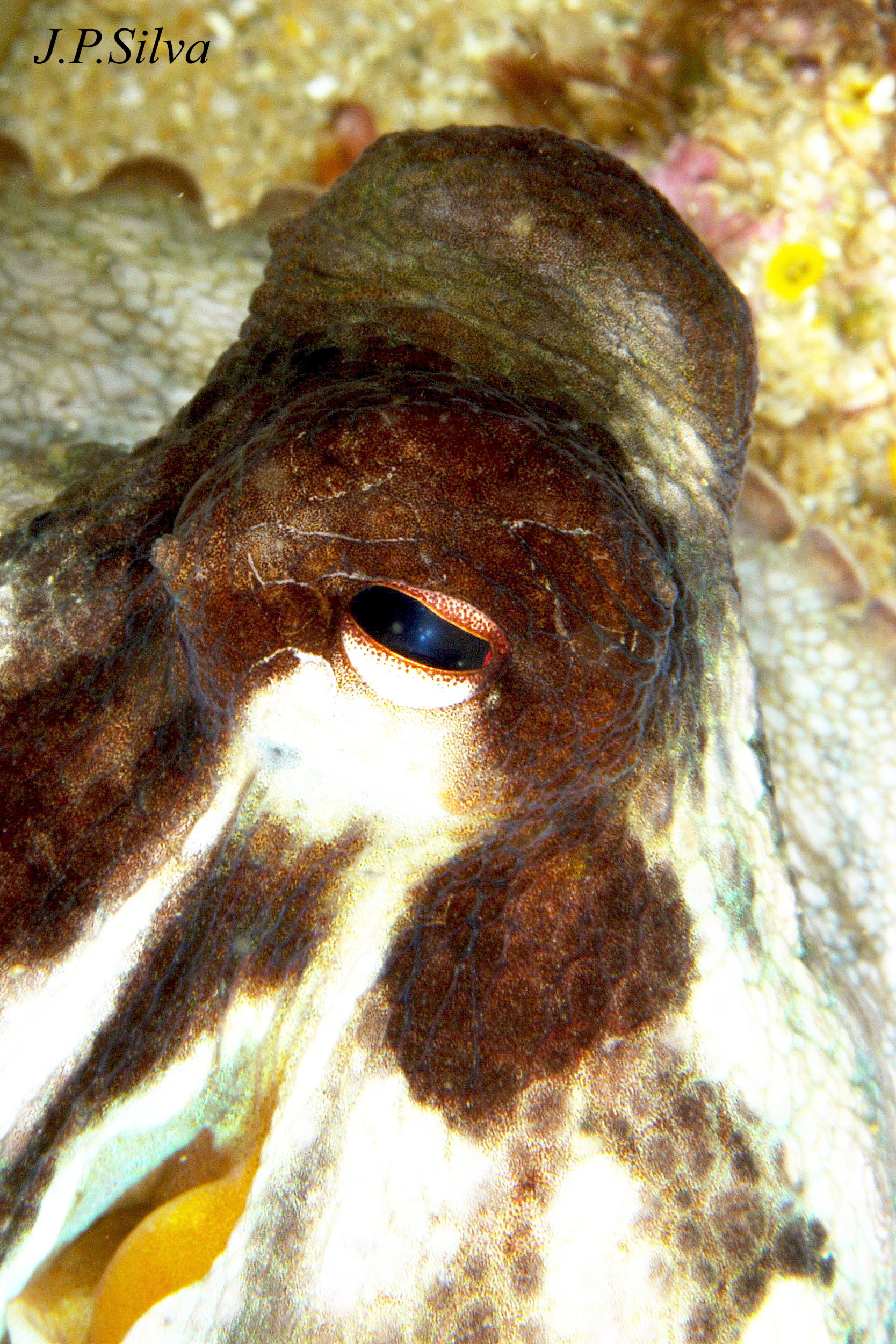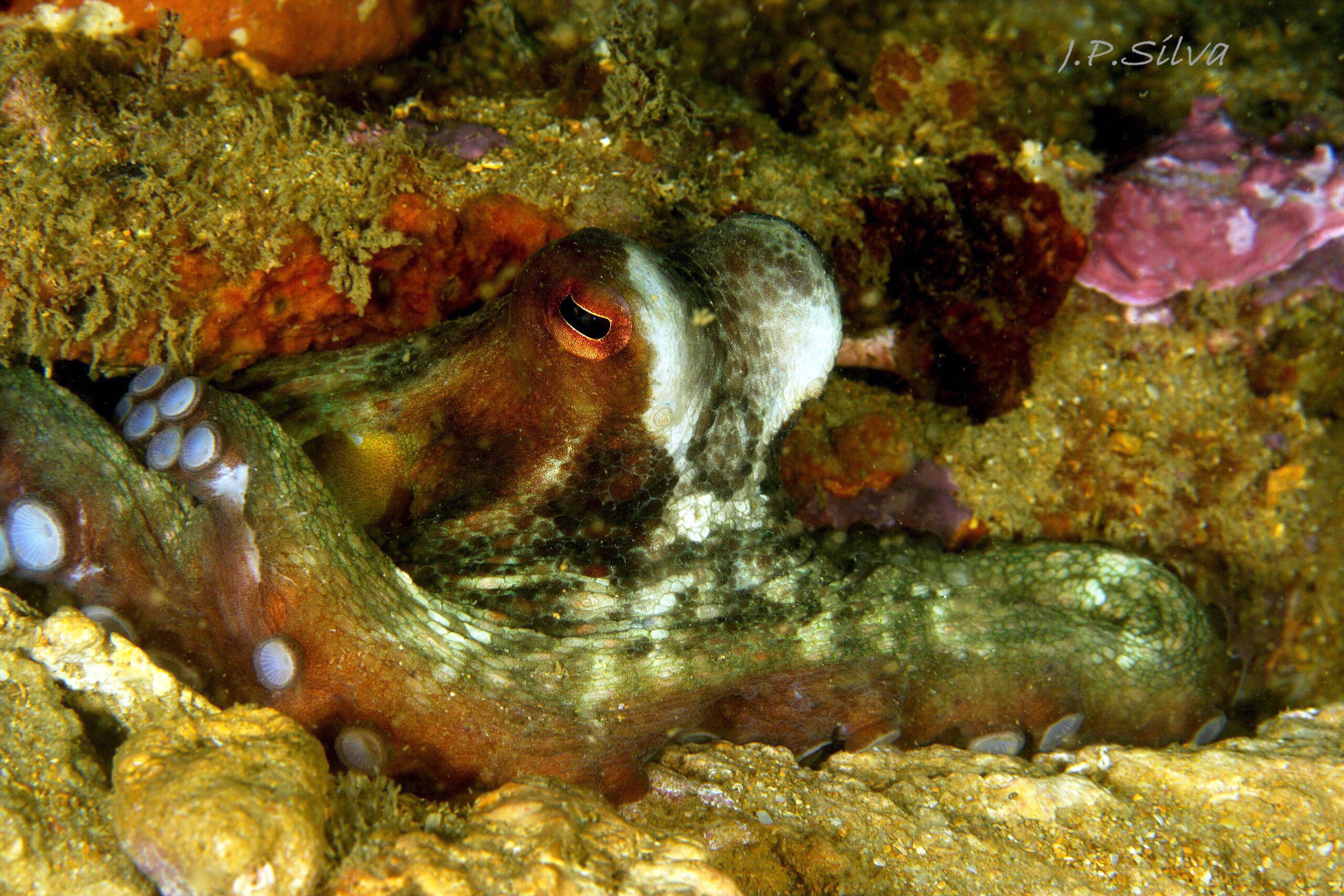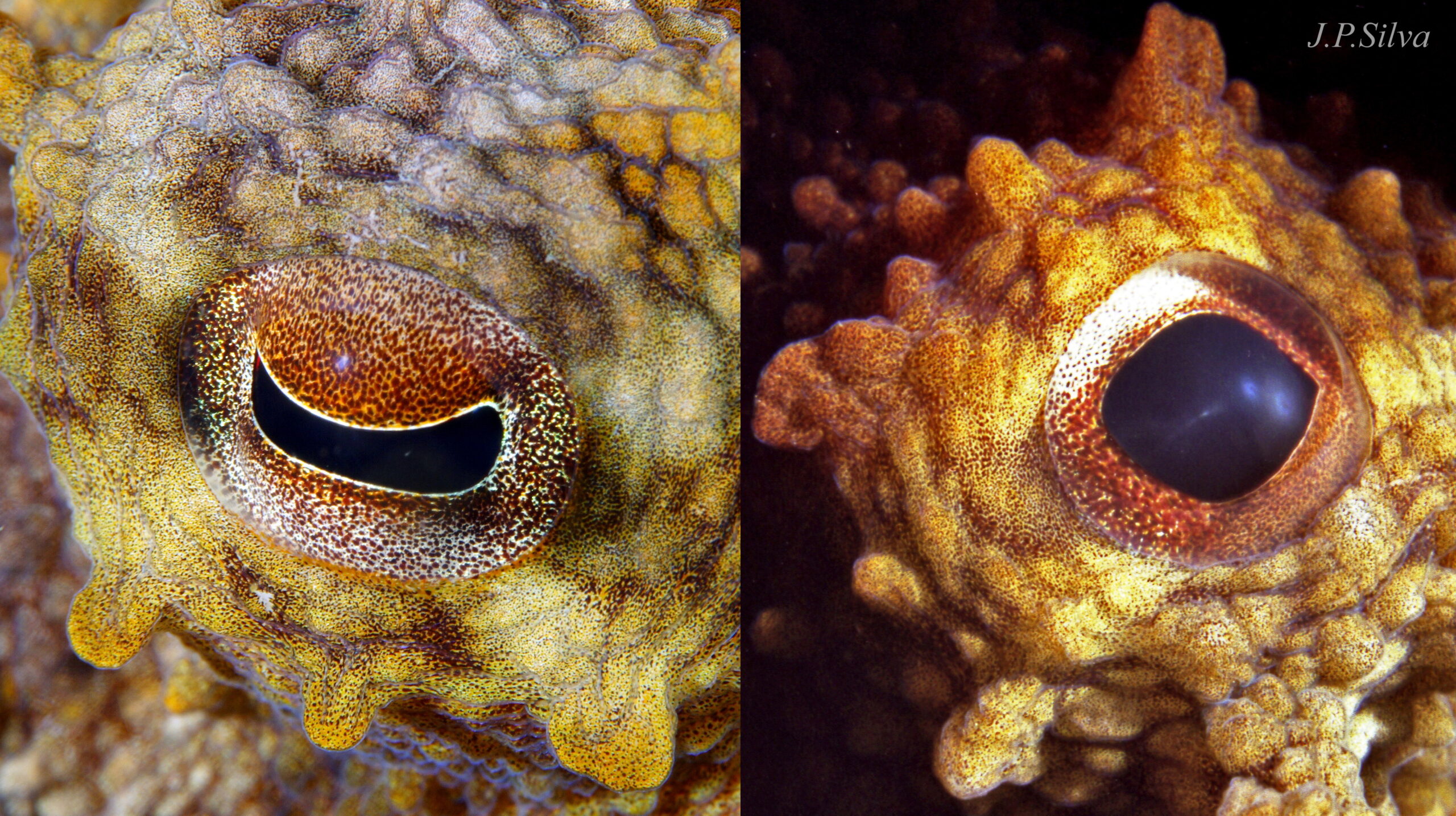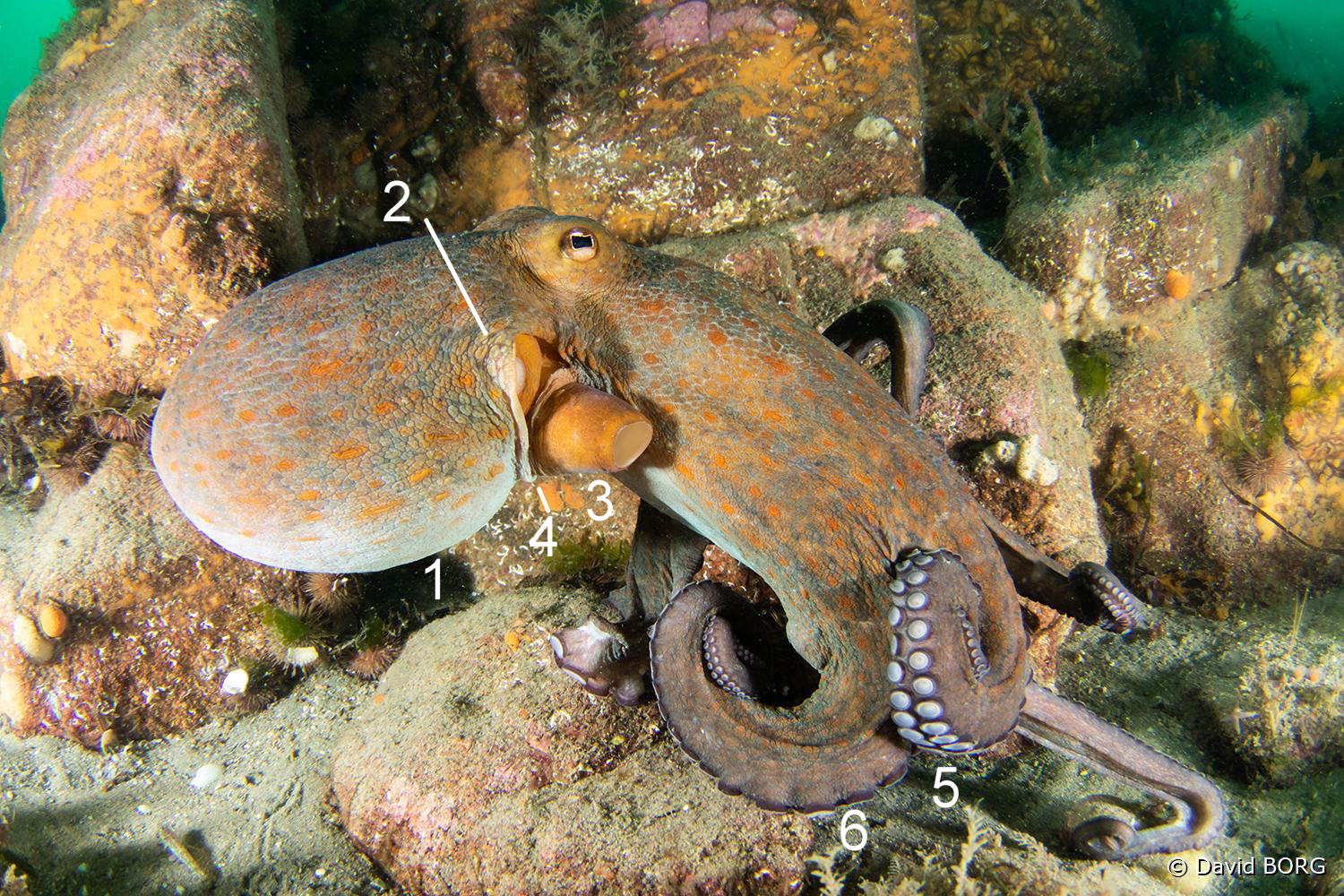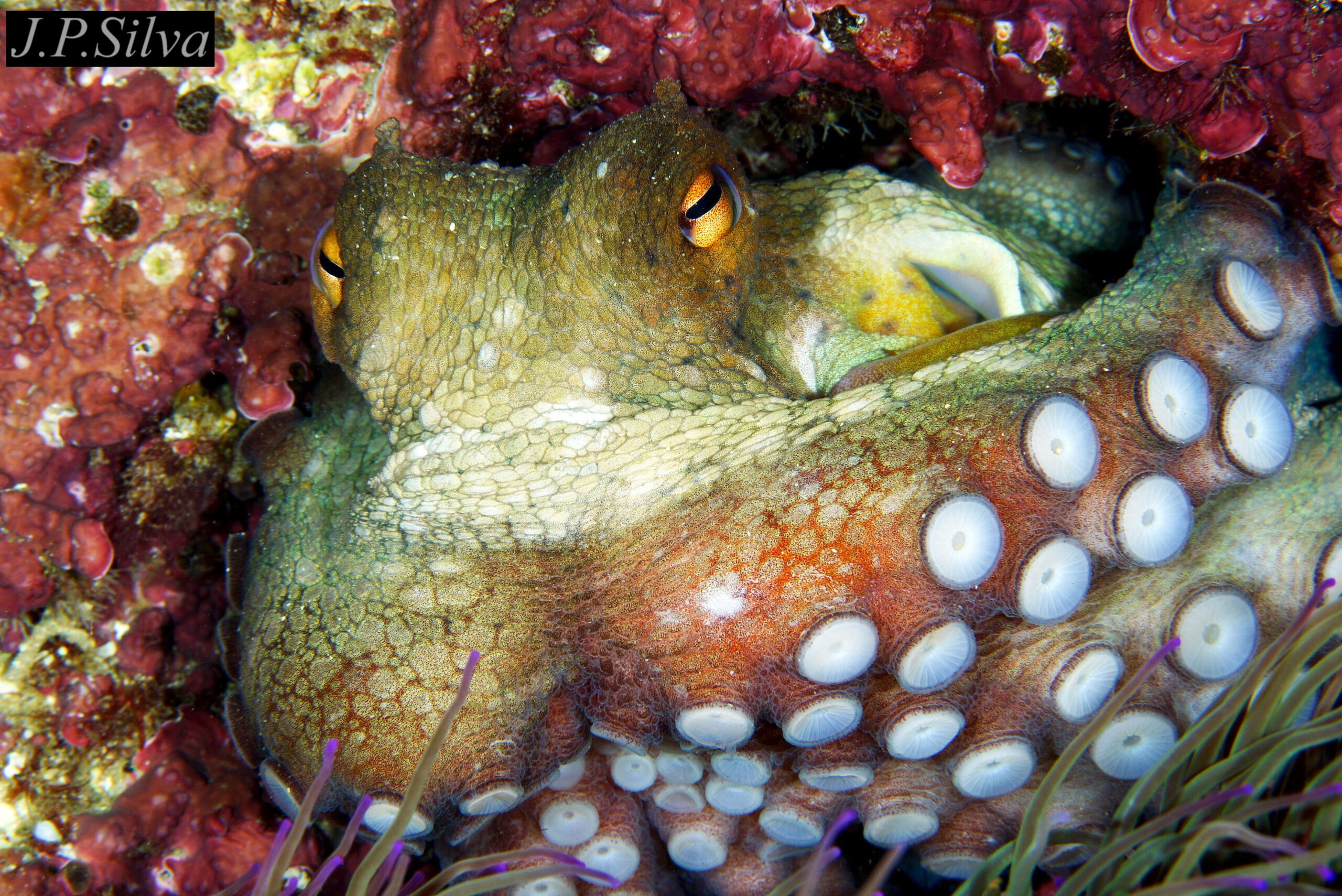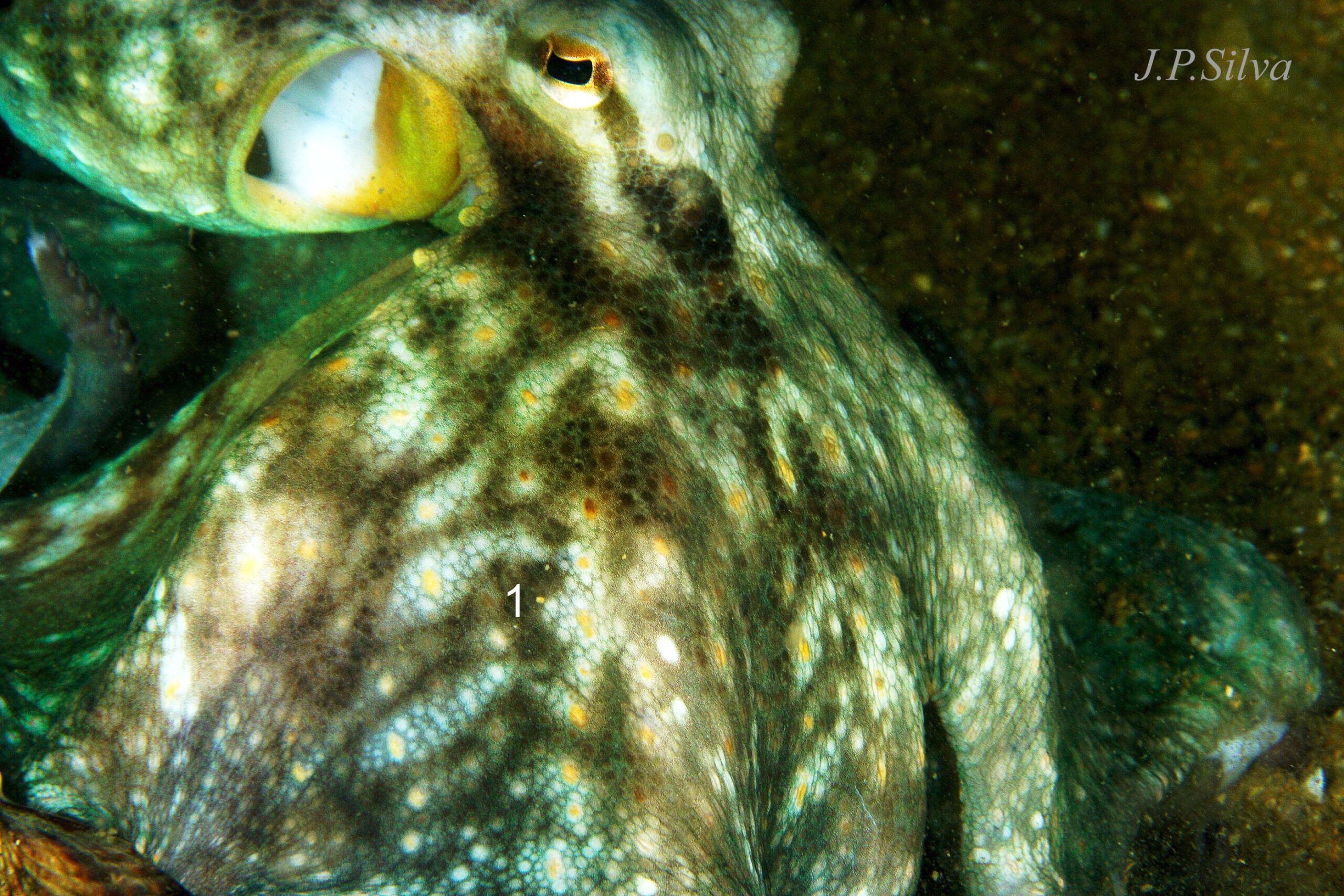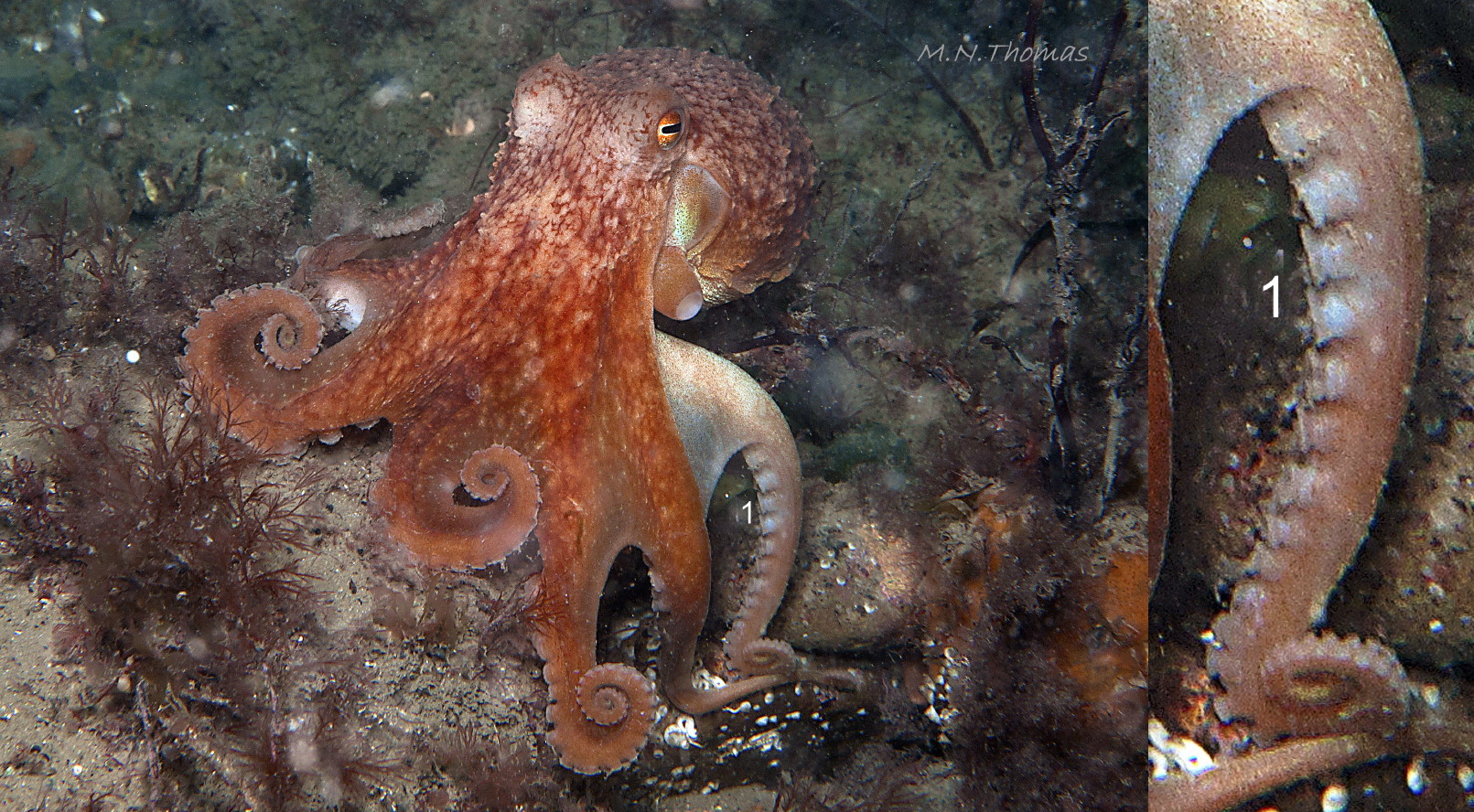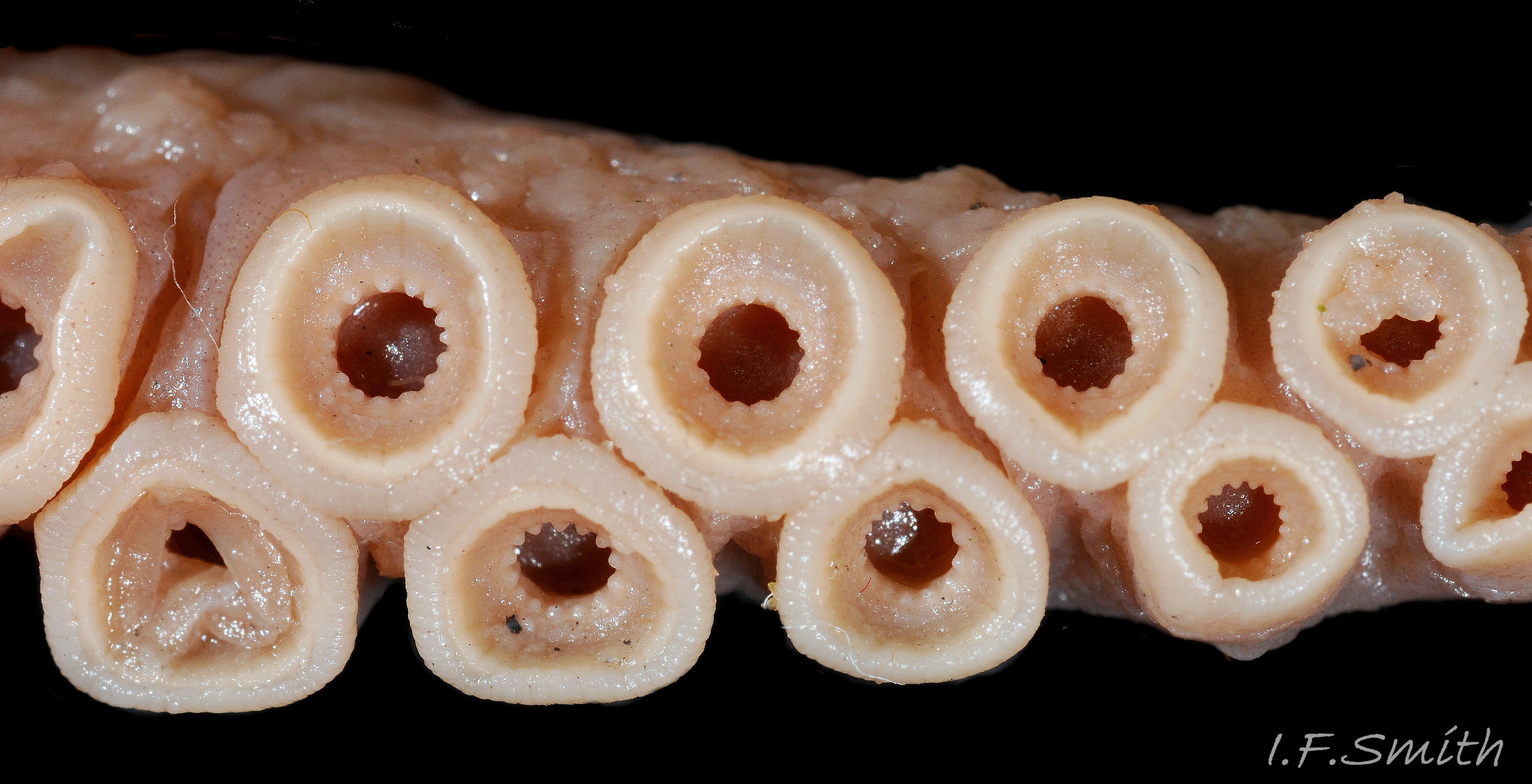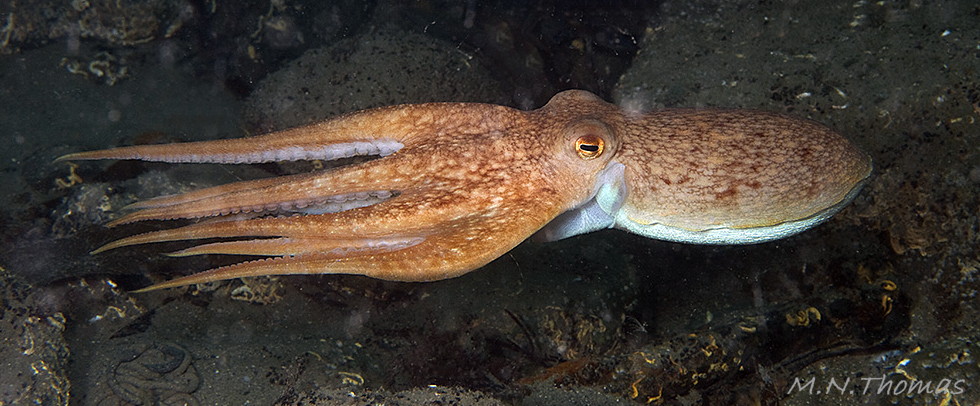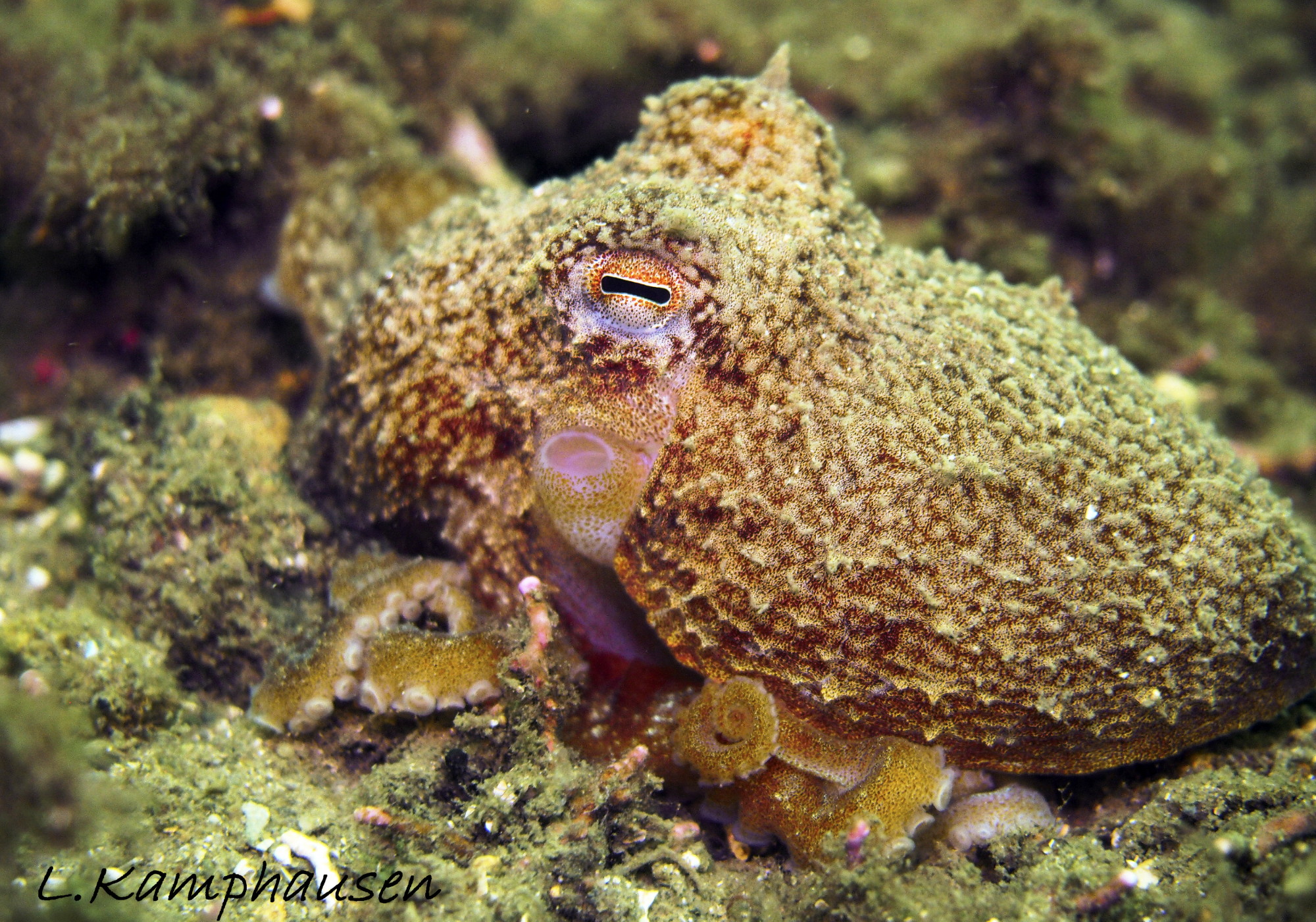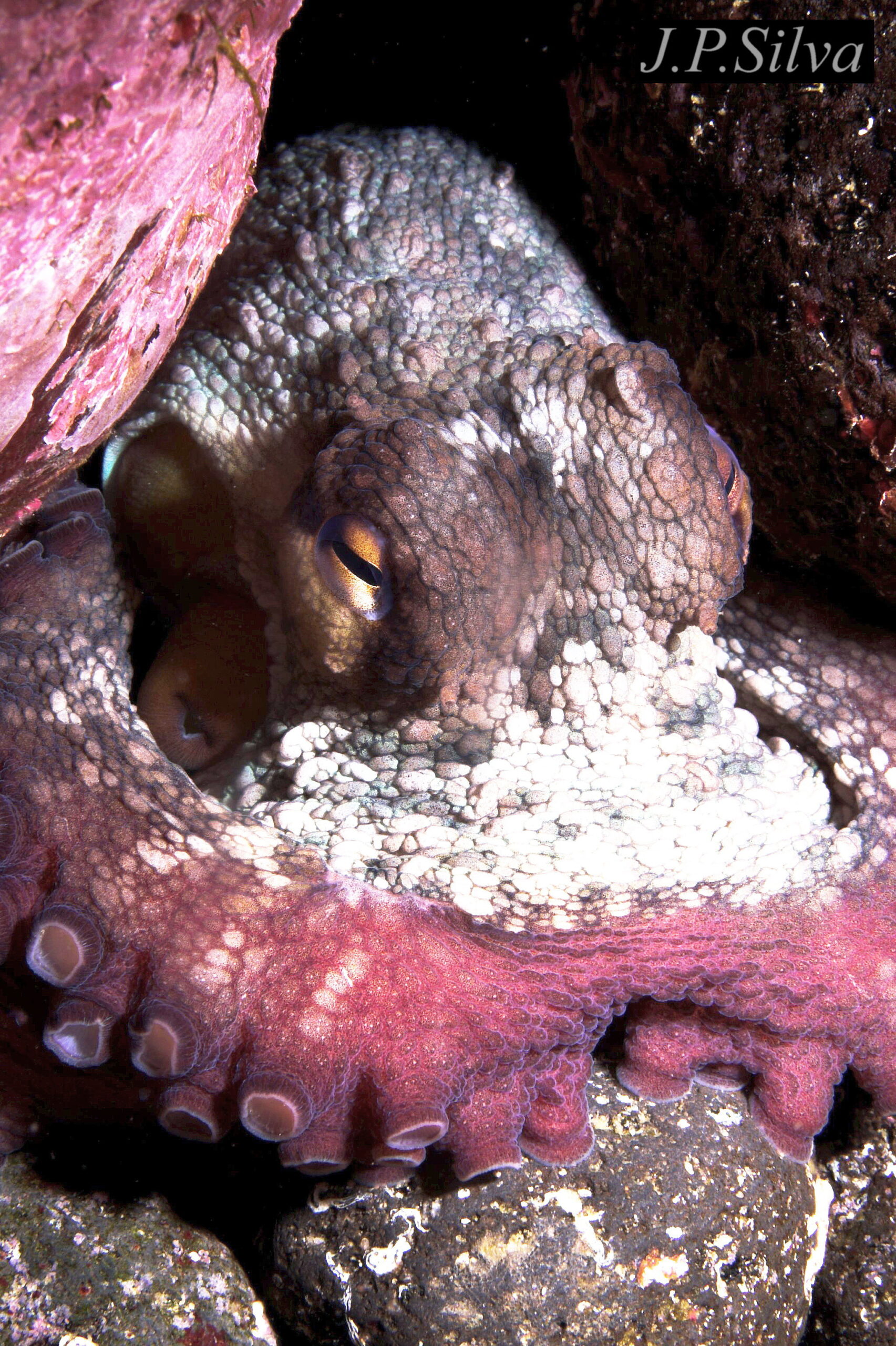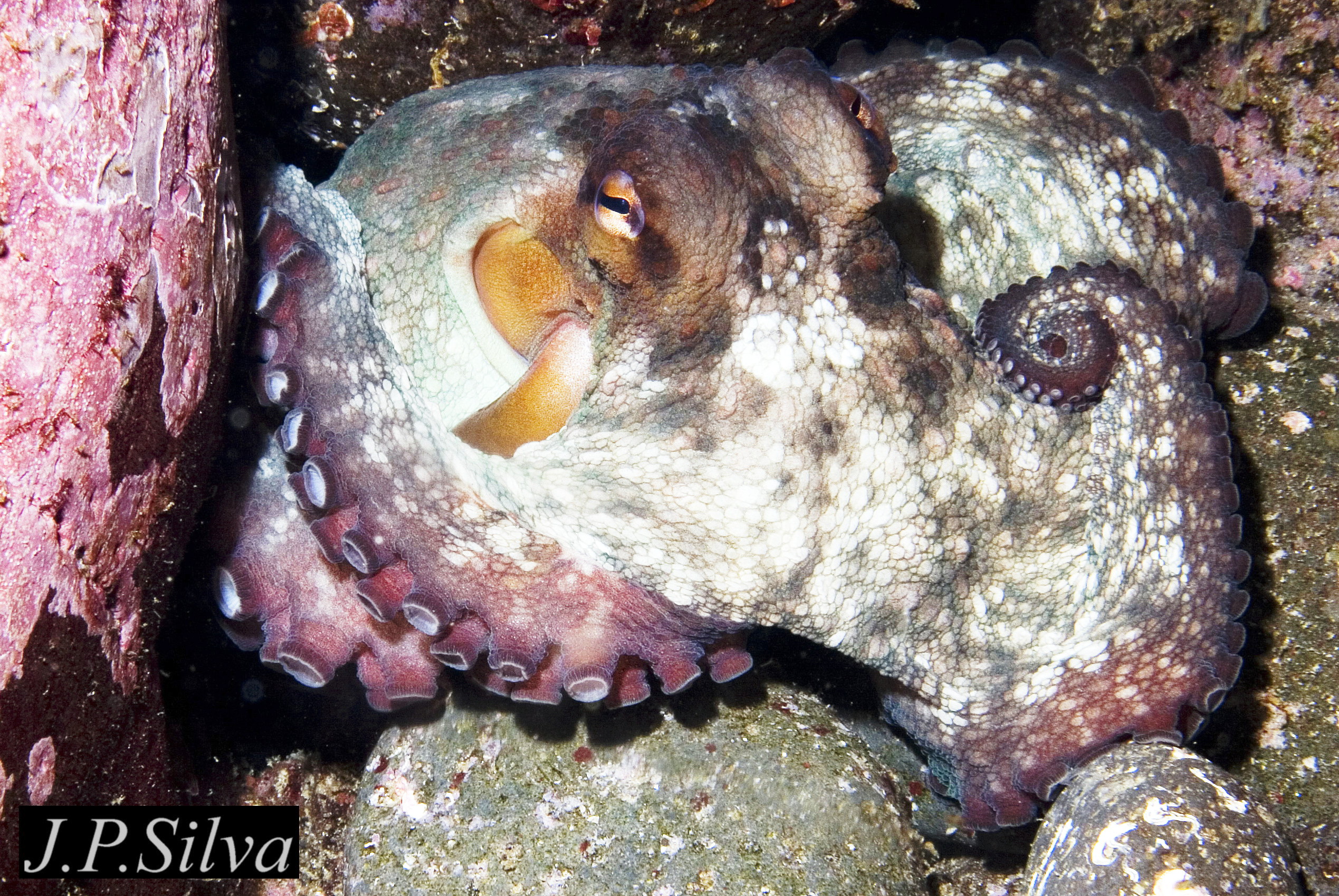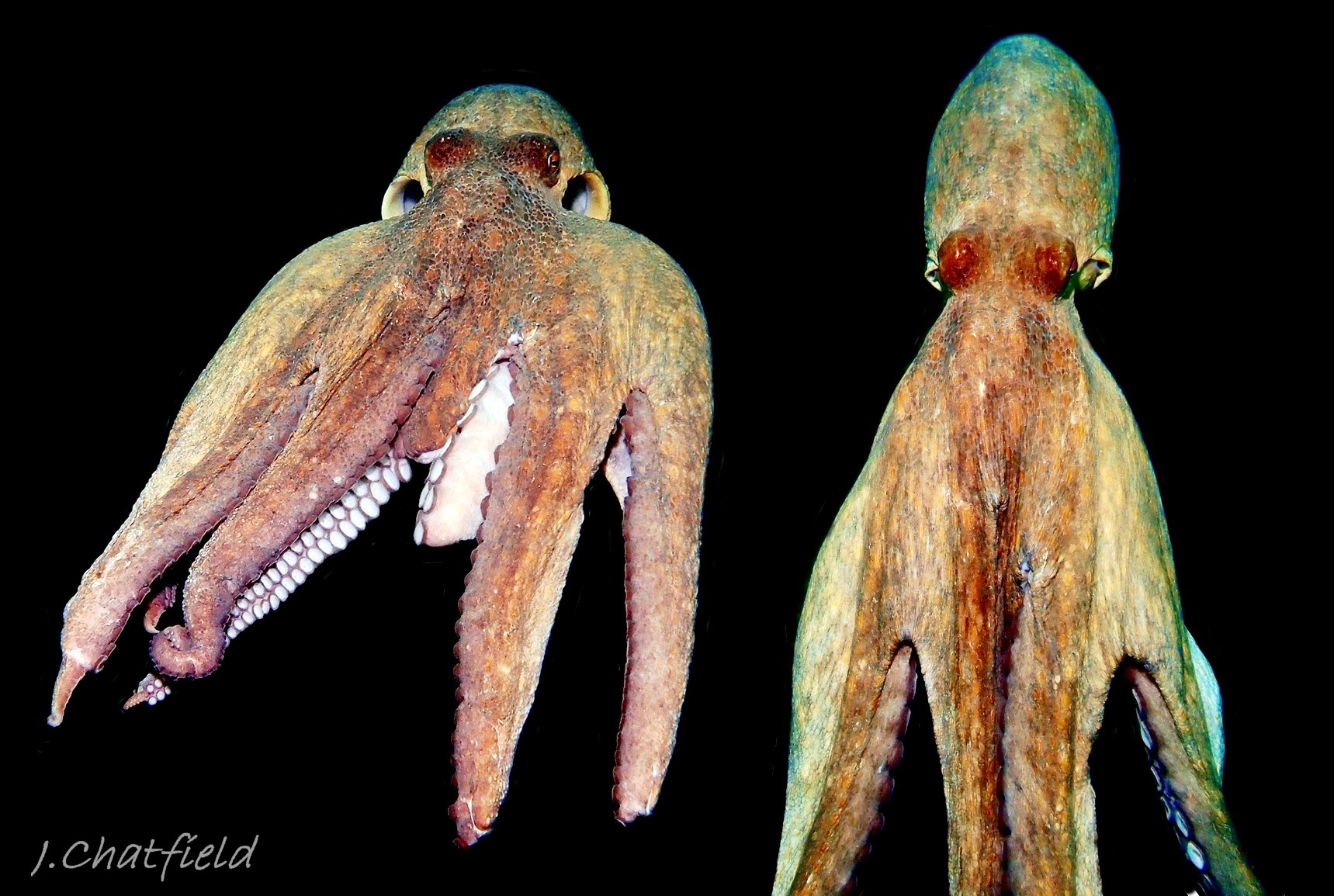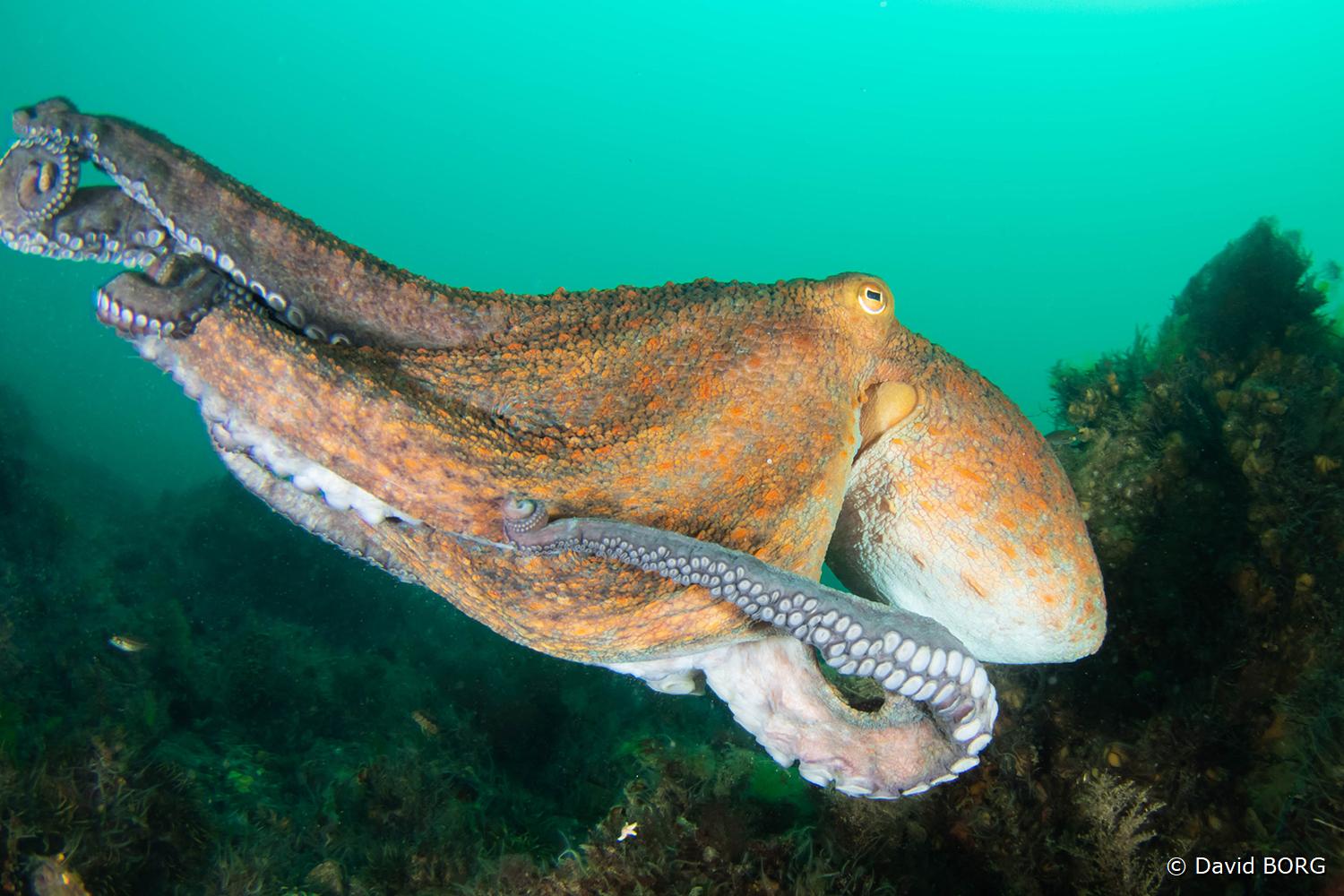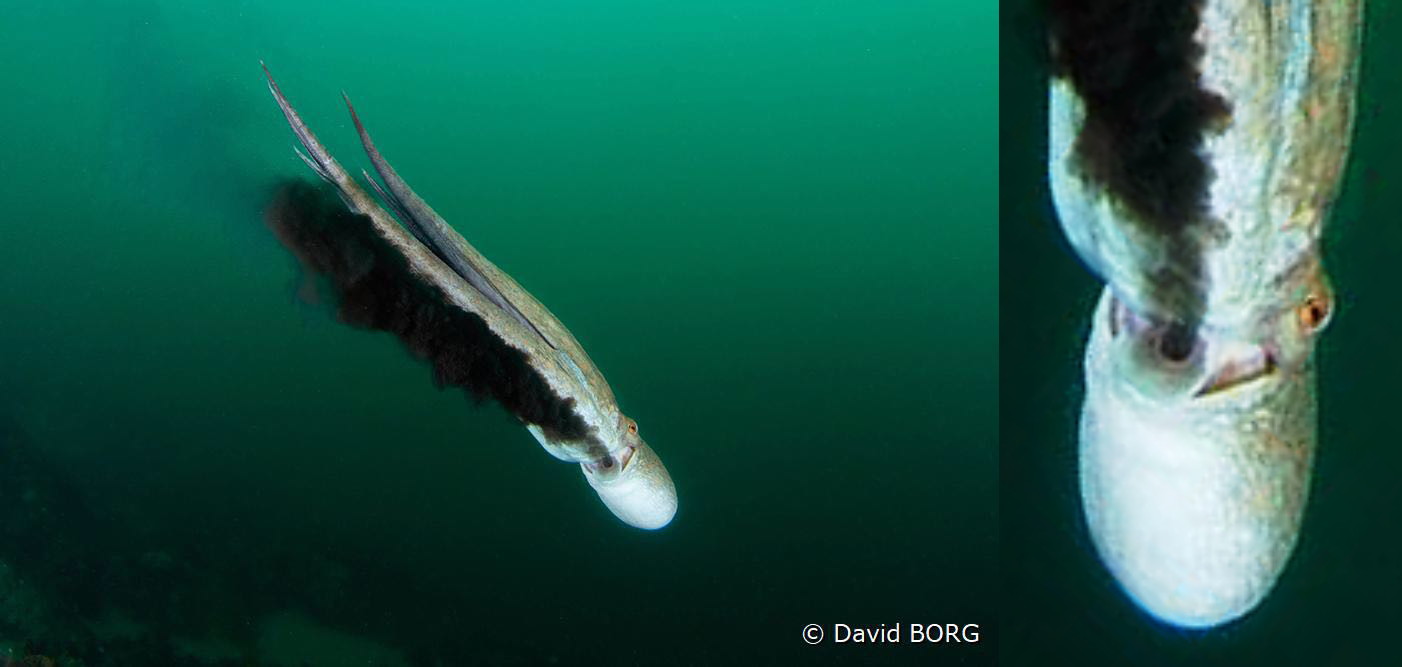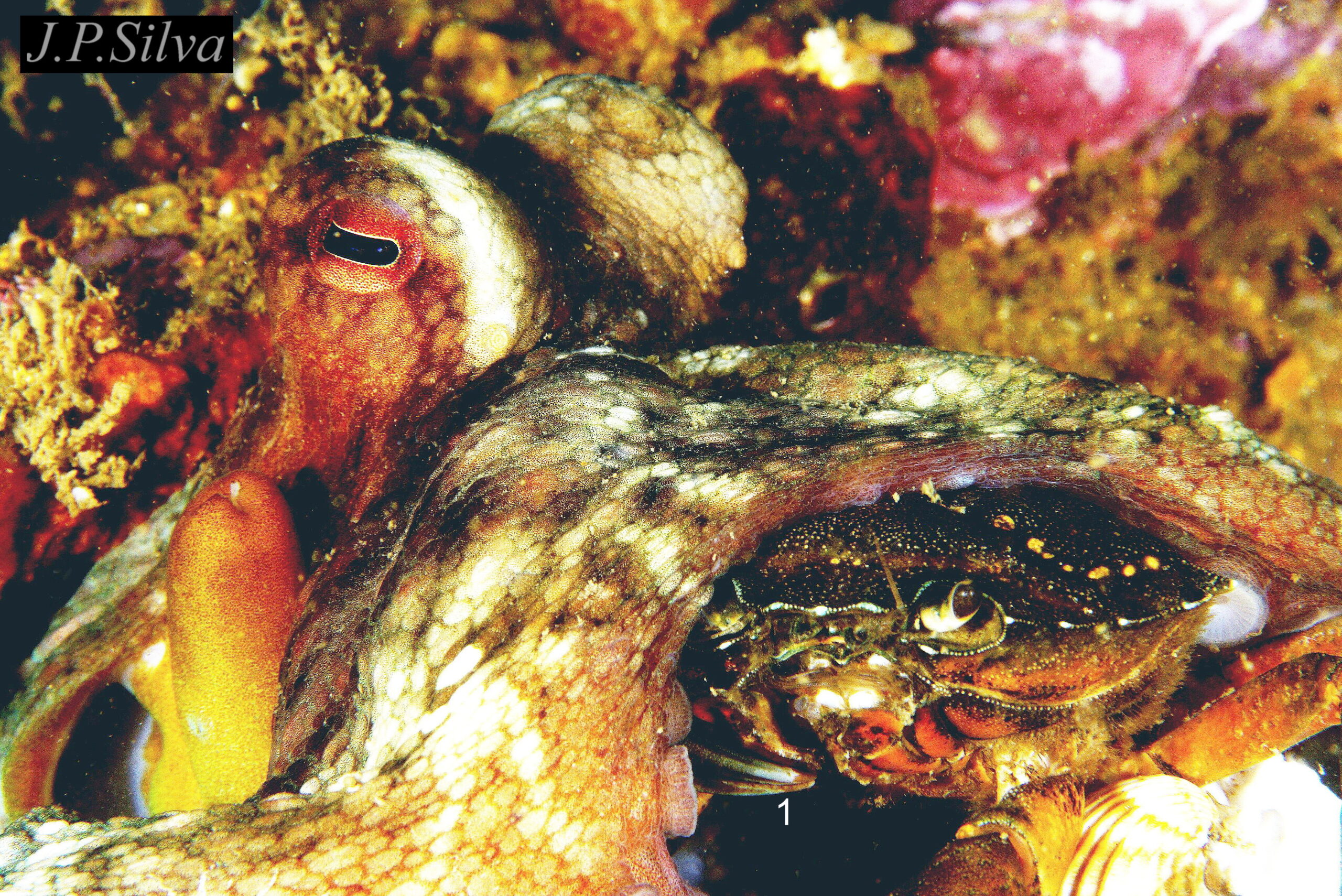Click image to enlarge with full caption. Main text below slider.
Octopus vulgaris Cuvier,1797
Joao Pedro Silva (images) & Ian Frank Smith (text).
PDF available at www.researchgate.net/publication/370845837_Octopus_vulgar…
Synonyms: no frequent synonyms (Jereb et al., 2016)
Current taxonomy: World Register of Marine Species
www.marinespecies.org/aphia.php?p=taxdetails&id=140605
Vernacular: Common octopus (English); Pieuvre (French); Pulpo común (Spanish); Gemeiner Krake (German); Chtapodi (Greek); Polpo comune, Polpo verace (Italian); Polvo (Portuguese).
GLOSSARY BELOW
Description
The total length of the body and arms is up to 1.8 m with mass over 20 kg in the Mediterranean, but it is usually less than 1 m long. The mantle forms an oval bag, often 250 mm long but up to 400 mm, which is fused with the head dorsally 01 Octopus vulgaris (Jereb et al., 2016). There is no ridge around the lateral margin of the mantle 02 Octopus vulgaris & 06 Octopus vulgaris such as found on Eledone cirrhosa. The mantle bag is open ventrally, and the exhalent respiratory funnel can be extended from the opening at varying angles to left 03 Octopus vulgaris and right. The anus is close to the funnel in the anterior of the mantle cavity. As well as digestive waste products, defensive ink is discharged from it, usually via the funnel 11 Octopus vulgaris .
The surface of the mantle and head has regular small circular patches and grooves (Jereb et al., 2016) and varies from fairly smooth 04 Octopus vulgaris to pronounced raised lobes 02 Octopus vulgaris & 05 Octopus vulgaris . The dorsal surfaces of the mantle, head and arms are covered in chromatophores which can rapidly change between black, grey, dark to light brown, greenish brown, reddish, purplish, yellowish and whitish in varying combinations. Ventrally, the mantle bag is often whitish 11 Octopus vulgaris .
The head has large, highly-developed eyes positioned dorsally on mounds that can be raised and dorsal 07 Octopus vulgaris & 08 Octopus vulgaris , tilted 09 Octopus vulgaris , or lowered 04 Octopus vulgaris . The pupils close to horizontal slits and can be opened wide in low light 10 Octopus vulgaris .
O. vulgaris has eight robust arms of equal thickness with rounded tips. They are 4 to 5.5 times the length of the mantle with the dorsal arms slightly shorter and, on males, the third arm on the right is shortened and its tip hectocotylized into a very small spoon-shape for transfer of spermatophores into the female (Jereb et al., 2016). Each arm has two rows of suckers which are distally a white disc with a dark rim 06 Octopus vulgaris ; sometimes the interior colour shows through the disc 18 Octopus vulgaris . The sides of the suckers and the undersides of the arms are often a shade of the dorsal colour 11 Octopus vulgaris and basally there is often a pinkish 21 Octopus vulgaris or reddish tint 12 Octopus vulgaris which may be the interior muscles showing through the integument.
The arms are linked along the proximal 15% to 20% by a web 13 Octopus vulgaris and there is a chitinous “parrot’s-beak” jaw where they meet. The only other hard body parts are slender “stylets”; vestiges of the ancestral internal shell.
Key identification features
Octopus vulgaris
The vernacular name “Common octopus” is a misnomer in Britain as, away from the south coast of England, it is absent and Eledone cirrhosa is common. In April 2023, all photographs of records on iNaturalist of ’O. vulgaris’ further north than the south coast of England were of E. cirrhosa or unrecognisable stranded cephalopods, possibly paralarvae, in poor condition.
1) Eight equal arms; males have one shortened arm used for copulation.
2) Each arm has two rows of suckers 06 Octopus vulgaris .
3) No ridge around the lateral periphery of the mantle. Surface texture varies from fairly smooth 06 Octopus vulgaris to elongate lobes 05 Octopus vulgaris .
4) Varied colours which can alter instantly; often a shade of dorsal colour on underside of arms including sides of suckers up to a dark rim around the white circular distal face of the suckers 11 Octopus vulgaris & 12 Octopus vulgaris ; sometimes internal colour shows through the discs 18 Octopus vulgaris .
5) Found living both littorally and sublittorally. In Britain, only on south coast of England in unusually hot summers.
Similar species
Eledone cirrhosa (Lamarck, 1798)
1) Eight equal arms; males have one arm shortened, which is used for copulation.
2) Each arm has a single rows of suckers 14 Octopus vulgaris COMPARE Eledone cirrhosa , but slender tips may have an alternating left and right row resembling a double row 15 Octopus vulgaris COMPARE Eledone cirrhosa .
3) Ridge around the lateral periphery of the mantle 16 Octopus vulgaris COMPARE Eledone cirrhosa . Surface nearly smooth or tuberculate 17 Octopus vulgaris COMPARE Eledone cirrhosa .
4) Mantle is whitish ventrally and terracotta to orange-red dorsally 16 Octopus vulgaris COMPARE Eledone cirrhosa .
5) Usually, sublittoral but in some years many are cast up alive onto the shore by storm waves.
Habits and ecology
O. vulgaris lives on the lower shore and benthically to 120 m on rocky, sandy or muddy substrates. It is mainly nocturnal, spending most of the day in a naturally occurring crevice or overhang 18 Octopus vulgaris or, on soft substrate, in a den constructed from loose stones and shells. It eats crustacea, fish and molluscs, including smaller individuals of O. vulgaris and may emerge from its den to pounce on passing prey. It moves on its arms and uses jet propulsion of water from exhalent funnel for rapid movement, but it rarely swims in open water, except to escape danger 06 Octopus vulgaris . Various shades of camouflaging brown and grey predominate 18 Octopus vulgaris . Other colours reflect activity or emotion. Sudden paling with darkening around eyes (dymantic display) 19 Octopus vulgaris , startles an attacker before it ejects distracting ink 22 Octopus vulgaris and jets away 20 Octopus vulgaris & fig 21 . When a crab or lobster is sighted 09 Octopus vulgaris its colour usually changes as it glides forwards and makes sudden lunge with aid of water jetted from the exhalent funnel. Crabs are enveloped by spread arms and web 13 Octopus vulgaris , usually from the rear to avoid the chelae 23 Octopus vulgaris . The arms hold prey while it is pierced by the horny beak, subdued by venom, injected with digestive enzymes and ingested in semi-liquid form. An apparently intact lobster in a lobster-pot is usually an empty husk if an octopus is with it. Its predators include wrasses, eels, sharks, seals, dolphins, otters and man. It can leave pools or aquaria and move out of water. Its lack of skeleton enables it to squeeze through gaps no wider than its beak.
To avoid being eaten, the male mates at arm’s length with his shortened third arm on the right, which is adapted into a hectocotylus for transfer of spermatophores into the female’s mantle cavity. The female produces 100 000 to 500 000 eggs, each 2 mm long on a 5 mm stalk, which she strings together and fixes as festoons to the roof of her den. She constantly guards, ventilates and cleans the eggs for up to five months. For this period she eats little or nothing, so her body wastes and she dies as the young hatch (Jereb et al., 2016).
The c. 2 mm long, short armed, transparent, nearly colourless paralarvae swim with jet propulsion in the plankton for over a month. They avoid light by descending into deeper water during daylight hours. Some are carried beyond the usual range of the species to the south coast of England where they settle in hot summers and may persist, occasionally in large numbers, until a cold winter kills them. On settlement, they metamorphose into adult form and habits. The lifespan is estimated as one to two years, terminating for females after a single brooding event (Jereb et al., 2016).
Distribution and status
O. vulgaris lives in the Mediterranean and eastern Atlantic from the west and north-west coasts of Africa, the Azores, Canary Islands and Cape Verde Islands to Bretagne, France and, occasionally in hot summers, to the south coast of England (Jereb et al., 2016). It becomes inactive at 7° C (Roper et al., 1984). The many records further north, where winter sea water temperatures fall to 7° C and below, such as on NBN Atlas species.nbnatlas.org/species/NBNSYS0000176785 should be regarded as misidentifications, mainly of Eledone cirrhosa, unless and, perhaps with climate change, until convincing substantiating photographs can be seen. In April 2023 all images of ‘O. vulgaris’ further north than the south coast England on iNaturalist www.inaturalist.org/observations?taxon_id=49315 were misidentified E. cirrhosa or unidentifiable remains of other cephalopods, which were challenged and withdrawn. Part of the cause of this frequent misidentification is the specific epithet ‘vulgaris’ (’common’) and the consequent mistaken conclusion that the common octopod of Britain, E. cirrhosa, is O. vulgaris.
Jereb et al. (2016) regard only those found in the area described above as O. vulgaris sensu stricto and cite molecular studies, some of which supported a single worldwide species and others which segregated some species.
Maps on iNaturalist and GBIF www.gbif.org/species/2289671 show records of O. vulgaris from the Caribbean, South Africa, Indian Ocean and East Asia. Jereb et al. (2016) wrote:
“Due to the significant geographic and temperature boundaries that exist between the geographical distributions of these forms (particularly for the east Asian “vulgaris”) and the absence of any plausible gene flow mechanisms, we choose to treat these forms individually [as described] below until their relationships are better resolved. This approach also enables regional knowledge and literature to be presented. The geographically disjunct forms (Fig. 39) are treated here under the following names:
Forms and their geographical distributions
Octopus vulgaris sensu stricto Mediterranean, central & NE Atlantic.
Octopus “vulgaris” type I Tropical western central Atlantic.
Octopus “vulgaris” type II Subtropical S.W. Atlantic: Brazil.
Octopus “vulgaris” type III Temperate S. Africa & S. Indian Ocean
Octopus “vulgaris” type IV Subtropical/Temperate S.E. Asia”
Acknowledgements
For use of images, I gratefully thank
David Borg www.flickr.com/photos/davidborgunderwaterpictures/albums ,
Rupert Brun flic.kr/p/5iDRL4 , James Chatfield,
Lisa Kamphausen www.flickr.com/photos/naturescot/ ,
Mark N. Thomas www.flickr.com/photos/marknthomas/collections/
and my co-author João Pedro Silva.
www.flickr.com/photos/jpsilva1971/albums
References and links
Morton, J.E., 1967. Molluscs.London.
Jereb, P., Roper, C.F.E., Norman M.D. and Finn, J.K. (eds.) 2016.
Cephalopods of the world, an annotated and illustrated catalogue of cephalopods species known to date. Volume 3 Octopods and Vampire Squids Rome, F.A.O. www.fao.org/3/i3489e/i3489e.pdf
Roper, C.F.E., Sweeney, M.J. & Nauen, C.E., 1984. FAO species catalogue. Vol. 3. Cephalopods of the world. An annotated and illustrated catalogue of species of interest to fisheries. FAO Fisheries Synopsis, Nº 125 vol. 3 www.fao.org/docrep/009/ac479e/ac479e00.htm
Yonge, C.M, & Thompson, T.E., 1976. Living marine molluscs. London. Collins.
Glossary
benthic= (adj.) living on the seabed.
chelae = hinged pincer-like claws on the anterior limbs of a crab or lobster.
chitin = semitransparent flexible horny protein, formula (C8H13O5N)n.
chitinous = (adj.) made of chitin, or resembling chitin.
chromatophores = tiny elastic pigment spots which can cause rapid change to body colour by expansion /contraction.
distal = away from centre of body or from point of attachment.
dymantic = startling a potential predator
hectocotylus = specialised arm on male octopus, squid etc adapted for transfer of spermatophores into female’s mantle-cavity.
integument = an enveloping layer, such as a skin, membrane or cuticle, of an organism or one of its parts.
maerl = substrate consisting mainly of fragments of calcareous seaweed, Lithothamnion calcareum.
mantle = fleshy, muscular, sac like body of octopods containing the viscera; creates jet propulsion by expulsion of water through the respiratory funnel.
paralarva = planktonic hatchling growth stage with short tentacles, small undeveloped suckers and little colour.
spermatophore = a package made of mucoprotein containing sperm.
